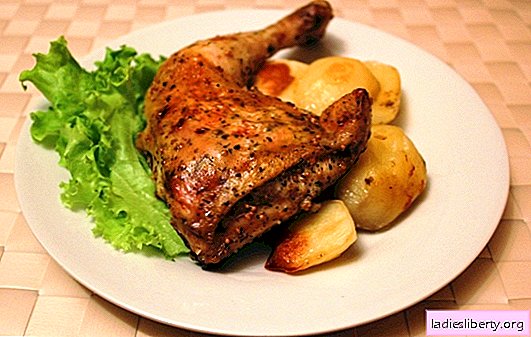
Determining the optimal time for planting roses is a question that remains open to many gardeners. The unpredictability of the climate makes us approach this process creatively: focus on the variety of planting material, the specifics of the variety, the characteristics of the plot, and many other factors.
When to plant roses: in the fall or in the spring?
There is an unwritten rule among flower growers: beginners plant roses in the spring, and professionals in the fall. The first are guided by the fact that in the spring it is easier for a plant to provide sufficient watering and care than in winter.
The experienced gardeners, in turn, are convinced that autumn humidity, stable soil temperature and cool nights are the best conditions for plant survival. The specimens planted to frost root well and begin to grow actively in spring.
Another plus of planting in the fall is that in the nurseries at this time a lot of grafted seedlings of any varieties are presented. After winter storage, imported and domestic samples are greatly weakened, which makes picking up suitable specimens in spring somewhat more difficult.
Selection of planting material
The first thing to do is pick up planting material. These can be plants with open or closed root systems, from local nurseries or foreign.
Roses with closed roots are planted both in spring and autumn, since they are sold during the period of active vegetation and, with good care, easily take root.
Domestic specimens are better to buy in the fall, and from trusted breeders. Imported seedlings need to be carefully examined: if the buds have already grown, planting is better to transfer to spring. In general, planting material brought from abroad is less frost-resistant, and therefore it is planted in the spring for acclimatization.
When choosing seedlings, you need to pay attention to the flowering time of the variety. Roses blooming in the spring better tolerate planting in early autumn. If specimens are selected for a harsh climate, you need to pay attention to the frost resistance indicator, which determines in which zone flowers can winter without shelter.
In fact, this information is not always confirmed, but experienced gardeners are sure that with proper autumn planting and good shelter, even weakly resistant varieties take root well.
Thus, for beginners who are not sure about the choice of variety, it is necessary to pay attention to the preparation of seedlings for winter.
Planting roses in autumn: growing conditions
When choosing a place for a flower garden, the following should be considered:
• in dark places roses grow weakly;
• in the sun, the color of the petals fades, flowering ends quickly;
• roses do not tolerate high humidity and strong winds, and spider mites quickly hit the bushes from dry air;
• It is better not to plant roses near trees with spreading crowns - after rainfall, dampness stays there for a long time.
It is better to choose a landing site with a deviation to the southeast or west. Roses need to be planted where, at lunchtime, a slight shadow will fall on them, and moisture will not linger in the soil. Ground water should not be higher than a meter from the surface.
Roses are best rooted at soil temperatures from 12 to 17 degrees. This process lasts three to four weeks, after which, with the onset of frost, roses go into rest.
The rooting time can be reduced if the root system is maintained in the growth stimulant solution during the day before planting.
Planting roses in autumn: soil preparation
The soil should be neutral, fertile and drained. Peat is added to alkaline soil, and lime to acidic soil. Loamy soil is improved with sand and manure. Dry sandy loam soil is enriched with stone flour and mineral fertilizers.
Quickly drying and freezing earth is heavy with clay (10 kg per bush). It is laid on the bottom of the pit (layer up to 7 cm).
In any case, during autumn planting, phosphate-potassium fertilizer (potassium sulfate, bone meal, superphosphate, etc.) should be added to the soil. This will speed up the preparation of the plant for the cold.
The soil from the pit should be properly mixed with additives, pour humus to the bottom of the pit and dig to the depth of the shovel bayonet. Next, fill the hole half with the prepared mixture and water it so that it settles before planting.
Planting roses in autumn: a method of planting
The pit should be of such a size that the roots freely enter it, do not break and do not bend. The size of the pit depends on the chosen variety: 40x40x40 cm for low-growing roses, 50x50x50 cm for park and bush roses, the depth of the pit for climbing trees is about 70 cm. In a clay-covered area, the dimension increases by 12-15 cm. The distance between the pits is on average 80 cm, between rows - 1-2 m.

The pit can be prepared in advance so that the soil has time to compact, or dig out immediately. In the latter case, it needs to be slightly dug up and brought to the required level.
Landing is placed in groups taking into account winter warming. Near the climbing varieties, leave space for wintering. Bushy and hybrid tea roses are arranged so that they can organize a general shelter.
The location should take into account the size of adult bushes: at least 1 m between park and climbing varieties, 55 cm between hybrid tea roses and Floribunda, up to 45 cm between undersized and small specimens.
In a harsh climate, flowers are planted sparsely. Thanks to this, the soil warms up better. If roses are grown for cutting, it is better to place the bushes denser to each other (about 25 cm), the distance between the rows is up to 50 cm. So the plants stretch out more and develop long peduncles.
Planting roses in the fall:
• loosen the bottom of the pit with a pitchfork, pour a mixture of earth and compost, sprinkle with ordinary soil on top;
• prune roots slightly with secateurs until fresh slices form;
• when planting in autumn, the ends of the shoots should be cut;
• place the seedling in the center of the pit, straighten the roots, pour a little earth on top so that the root neck is 5 cm deep from the surface of the earth;
• water the seedling plentifully;

• tamp the ground;
• cover the bush with loose soil, make a roller about 15 cm in height (when the rose begins to grow, it can be leveled);
• In autumn, the earth around the bush should be mulched with compost or mowed grass.
Further care
Subsequent care of roses, which were planted in the fall, is to control the air temperature, since there is no need for plentiful watering. At a temperature of 5-7 degrees, it is recommended to cover the bushes with spruce branches and install semicircular wire frames under them. The design is covered with roofing material and polyethylene.
The optimal height of the structure is 40-50 cm. Its dimensions vary depending on how many seedlings will be under it. It is important to remember that the more air under cover, the easier winter will pass.
At a temperature of 10 degrees, the edges of the film need to be pressed a little to the ground. In the spring, shelter is not immediately cleaned: first, light ventilation is provided to prevent sunburn.
Subject to all the above recommendations, even a beginner will be able to grow beautiful roses - no difficulties in planting and care will arise.











